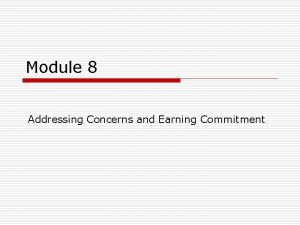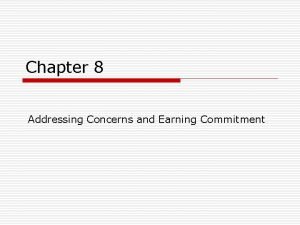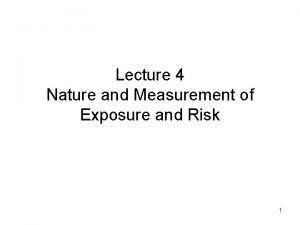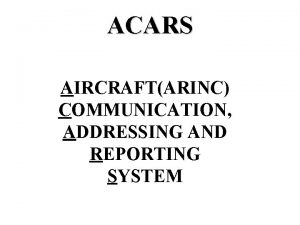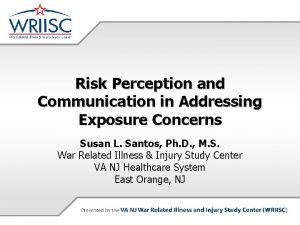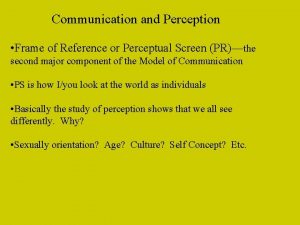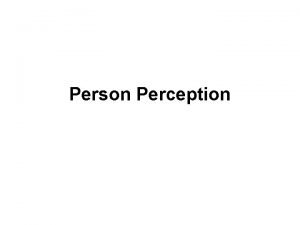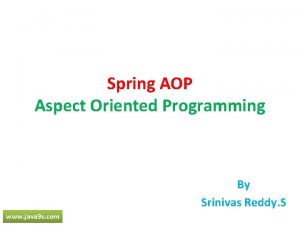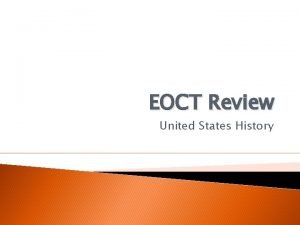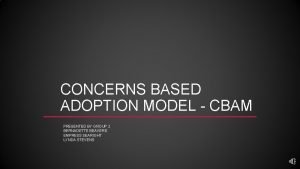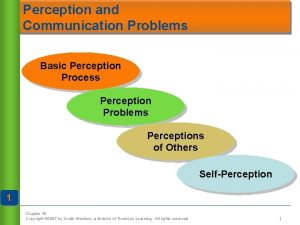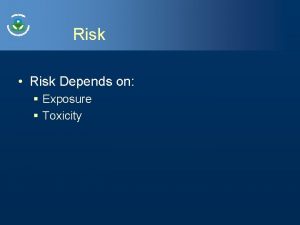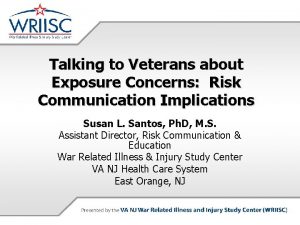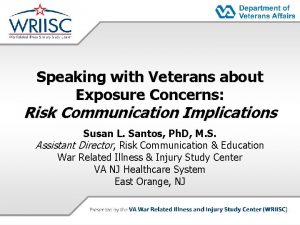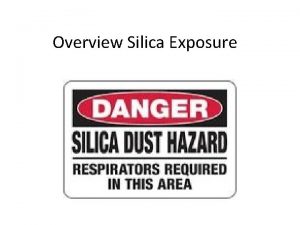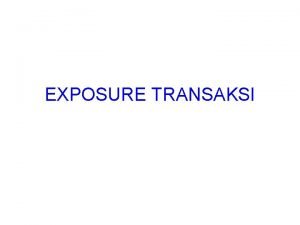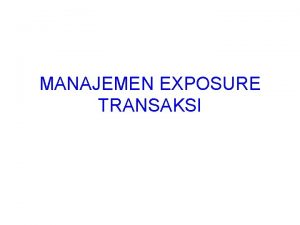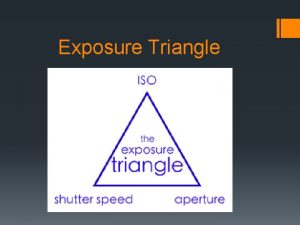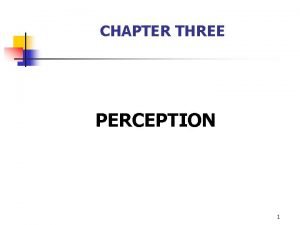Risk Perception and Communication in Addressing Exposure Concerns





























- Slides: 29

Risk Perception and Communication in Addressing Exposure Concerns Susan L. Santos, Ph. D. , M. S. War Related Illness & Injury Study Center VA NJ Healthcare System East Orange, NJ

Overview § Veterans’ exposure concerns § Principles and implications of risk communication § Understanding risk perception § Do’s and Don’ts of provider-Veteran communication

Top Ten Environmental Exposures: Gulf War 1. Protective gear/alarms (82. 5 %) 2. Diesel, kerosene & other petrochemicals (80. 6%) 3. Oil well fire smoke (66. 9%) 4. Ate local food (64. 5%) 5. Insect bites (63. 7%) 6. Harsh weather (62. 5%) 7. Smoke from burning trash/feces (61. 4%) 8. Within 1 mile of missile warfare (59. 9%) 9. Repellants & Pesticides (47. 5%) 10. Paint/solvents & petrochemicals (36. 5%) N=651 Schneiderman AI, et al. American Public Health Association, 133 rd Annual Meeting, Philadelphia, PA, December 14, 2005.

Data from Risk Perception Pilot Survey and Focus Groups Primarily Gulf War Veterans Substances mentioned as having the most exposure: Moderate High § Air Pollution 28. 6% 54. 3% § Petrochemicals 25. 7% 45. 7% § Vaccines 11. 6% 68. 8% § Pesticides 28. 6% 22. 9% Most unsure of being exposed was: § Depleted Uranium 37. 1%

Data from Risk Perception Pilot Survey and Focus Groups § Sensory cues are viewed as evidence of exposure § Protective measures (alarms, suits) are seen as evidence of exposure vs limiting the potential for exposure § Dread, uncertainty and lack of trust exacerbate health concerns § Veterans aware of media coverage of exposure concerns § Having information on exposure potential is important

Top Ten Environmental Exposures of concern: OEF/OIF 1. Smoke from burning trash or feces (44. 6%) 2. Sand dust storms (41. 5%) 3. Gasoline, Jet Fuel, Diesel Fuel (21. 1%) 4. Depleted Uranium (19. 0%) 5. Paint, solvents, other petrochems (15. 2%) 6. Oil well fire smoke (14. 9%) 7. Contaminated food and water (14. 4%) 8. Anthrax Vaccine (14. 2%) 9. Multiple Vaccinations (13. 9%) 10. Vehicular Exhaust (10. 3%)

What is Risk Communication? § “… an interactive process of exchange of information and opinions among individuals, groups, and institutions. ” § “It involves multiple messages about the nature of risk and other messages… that express concerns, opinions or reactions to risk messages… as well as information on what to do to control/manage the (health) risk. ” (National Research Council, 1989)

Why Risk Communication? § High concern § Low trust § Differential relationships of power § Communicating complex information § High uncertainty or expert disagreement

Principles of Effective Risk Communication § Know why you are communicating § Identify and understand your patient’s concerns, beliefs and perceptions § Recognize that trust and credibility are key § Structure provider-Veteran communication to respond to Veteran’s concerns and provide information to facilitate collaborative decision- making § Good risk communication is two-way - listening not risk speak

Risk Perception and the Importance of Trust and Credibility

Know Your Audience § Effective communication requires knowing your patient as a person – and enables you to understand the patient’s problems and concerns from their perspective § Understand their perceptions as valid and rational…not “misconceptions” § Understand the patient’s theories, beliefs, and prognosis of illness/symptoms as part of exposure assessment

There are Two Languages Communicating Health Risk “Expert” Assessment of Risk “Public”/Media Assessment of Risk Scientific Probabilistic Acceptable Risk Changing Knowledge Comparative Risk Population Averages A death is a death Intuitive Yes/No Safety Is it or isn’t it? Discrete Events Personal Consequences It matters how we die

Importance Of Risk Perceptions § Risk perceptions are related to health behavior, medical-decision making, and the processing of health information § Lay risk perception is influenced by a wide variety of cognitive, motivational, and affective factors § These psychological processes often lead to errors in risk perception among laypeople and the media § Information does not cure “wrong” perceptions

Understanding Risk Perception Less Risky § § § Voluntary Individual Control Familiar Low Dread Affects Everybody Naturally Occurring Little Media Attention Understood High Trust Consequences Limited/Known Benefits Understood Alternatives Available More Risky § § § Involuntary Controlled by Others Unfamiliar High Dread Affects Children Human Origin High Media Attention Not Understood Low Trust Catastrophic Consequences Benefits Unclear No Alternatives

What Makes A Source Credible Assessed in First 30 Seconds Empathy and/or Caring Competence and Expertise Commitment and Dedication Honesty and Openness

Who The Public Perceives As Credible MOST CREDIBLE § Local citizens perceived as neutral, respected, informed about the issue § § § § § Health/safety professionals (nurses, physicians, firefighters) Professors/educators (especially from respected local institutions) Clergy Non-profit organizations Media Environmental/advocacy groups Federal government State/local government Industry “For profit” consultants LEAST CREDIBLE

Establishing Trust & Credibility § Third party endorsements from credible sources § Demonstrating supporting characteristics § Caring § Honesty § Competence § Dedication § Organizational credibility § Consistency § Accessibility § Track Record

Risk Perception and Uncertainty § Scientists/physicians recognize uncertainty exists and information will change over time § Lay persons view changing or incomplete information as a sign of uncertainty and lack of knowledge § High uncertainty increases perception of risk § People see uncertainty as greater if unfavorable information is presented last

Risk Perception & Symptom Reporting § Perceptions of illness associated with chemical, biologic, etc. exposure can result from psychological processes individuals apply to understanding and interpreting physical experiences and events § Symptoms are experienced within a psychosocial context which gives meaning to the symptomology and a framework for causal explanations

Risk Perception Model Risk Perception Mental Models Expectations Emotion and Stress Triggers sensory cues Somatic Change Illness Perception and Interpretation Illness Fig. 1. Model of the relationship between risk perception, stress, somatic change, and illness perception

5 Stage Model for Responding in Situations of High Concern and/or Low Trust 1. Active listening and emphatic responses 2. Provide short clear statements of findings -- your main point 3. Provide 1 -2 facts to support main point 4. Repeat the statement/main point 5. Next steps/follow-up by provider and patient

Physician-Veteran Communication § Listen and restate the Veteran’s concern § Discuss important concepts in assessing exposure § Route and duration of exposure § Concept of dose-response § Determine Veteran’s exposure profile § Discuss risk of long-term health effects in relation to type of exposure

Physician-Veteran Communication § Explain exposure and relationship with symptoms of concern/health problems § Address risk perception issues including uncertainty § Involve the Veteran in examining the research § Acknowledge “errors” as needed § Discuss provider’s basis for conclusions § Check back on Veteran’s understanding

Physician-Veteran Communication § Manage expectations – Veterans and providers § Acknowledge perceptions about beliefs § e. g. Low trust, frustration about classified information, changing science, etc. § Avoid debate or being confrontational § Listening opens channels of communication § Provide objective scientific information and have a dialogue

Differences between Gulf War and Prior Veterans § Prior Veterans have health problems or symptoms they relate to past exposures § Current Veterans have questions and concerns, not necessarily health problems or symptoms § Different communication goals § Inform/educate OEF/OIF Veterans § Understand perceptions and shift behaviors of prior Veterans

Do’s and Don’ts § Listen: Risk communication is two-way § Veteran has much information to offer § Recognize empathy and trust are extremely important § Convey caring before information/science § Explain concepts of exposure § Explain how exposure is determined § Translate dose-response § Assist with knowledge gap (belief that any level of exposure may cause harm)

Do’s and Don’ts § Explain uncertainty § Provider/Veteran perception of uncertainty likely differs § “We have no data to suggest that…”; “It doesn’t appear that…” § Important to “bound it” with explanation § Reflect Back § The Veteran’s understanding of what you find and do not find § Be collaborative § Goal is to increase Veteran participation in decisionmaking § “Let’s work on this together”

Do’s and Don’ts § Treat Veterans with dignity and respect § Their worldview/perception is valid, not misperception § Don’t rely on your position of authority § Not a substitute for good communication § Don’t try to convince them you have more knowledge: Instead, explain why you believe § Don’t use medical short-cuts

Summary § Risk communication is an important part of addressing Veterans’ exposure concerns § There are things you can do to improve communication § Recognize our goal is to assist the Veteran in making the best decisions to support their health and well-being
 Addressing concerns and earning commitment
Addressing concerns and earning commitment A traditional method of earning commitment is the
A traditional method of earning commitment is the Flat addressing vs hierarchical addressing
Flat addressing vs hierarchical addressing Managing economic exposure and translation exposure
Managing economic exposure and translation exposure Transaction exposure vs economic exposure
Transaction exposure vs economic exposure Managing economic exposure and translation exposure
Managing economic exposure and translation exposure Operating exposure adalah
Operating exposure adalah Credit risk market risk operational risk
Credit risk market risk operational risk Nature of exposure and risk
Nature of exposure and risk Horizontal e vertical
Horizontal e vertical Acars message format
Acars message format Risk exposure index
Risk exposure index Risk exposure in software engineering
Risk exposure in software engineering Risk perception theory
Risk perception theory Frame of reference in communication
Frame of reference in communication How perception affects communication
How perception affects communication Joys and concerns
Joys and concerns Joys and concerns prayer
Joys and concerns prayer Joys and concerns images
Joys and concerns images Residual risk and secondary risk pmp
Residual risk and secondary risk pmp Business vs financial risk
Business vs financial risk Relative risk
Relative risk Relative risk
Relative risk Java9s
Java9s Software design separation of concerns
Software design separation of concerns Network layer design issues
Network layer design issues What are the concerns of the constitutions?
What are the concerns of the constitutions? Lumi sps
Lumi sps Concerns-based adoption model
Concerns-based adoption model The litmus test of a company's code of ethics is
The litmus test of a company's code of ethics is
